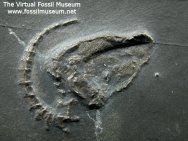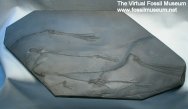Hunsrück Slates Bundenbach
Bundenbach
Hunsrück Slate of Germany
|
Related Interest: Fossils of the Bundenbach Hunsruck Slate |
| Bundenbach - Lower Devonian Hunsrück Slate of Germany
The best localities for well-preserved fossils are in the communities of Bundenbach and Gemünden. The slates were widely quarried in the past, primarily from small pits, of which over 600 are known. Today, only a single quarry remains open in the main fossiliferous region of Bundenbach. Unlike other famous Lagerstätten, the Hunsrück Slate has never undergone detailed sedimentological examination. The slates are of Early Devonian age, deposited during the Late Pragian to Early Esmian Ages, making them 396-390 million years old. The sediments were deposited to thicknesses estimated at 4,000 meters (4,400 feet) in a number of offshore basins that were separated by swells. The main belt of deposits runs for about 150 km (100 miles) from northwest to southeast. To the south the thickness drops to only 200 meters (220 feet). Thus deposition appears to have occurred in subsiding basins that were separated by swells which had reduced and partly sandy sedimentation. Water depth in the offshore environment of the slates has been estimated at 40-60m (44-66 feet), an estimate borne out by the well-developed eyes of arthropods and vertebrates found here. Fossil
remains are very often covered by a pyritic surface layer. When
burial occured rapidly, fossils were commonly completely replaced
with pyrite, in which case preservation was excellent. Such pyritized
fossils are often examined by the X-ray technique. This considerably
facilitates the preparation process, as the fossils are not otherwise
easily separated from the fine-grained sediment matrix. Having
an image of the as-yet-unexposed The deposits are not a perfect representation of the ecology, however, for several reasons: 1. Due to the dissolution of thin calcareous shells of brachiopods, gastropods, and cephalopods, they are rarely represented 2. Because the slates became famous for their arthropods and echinoderms, the quarrymen concentrated on their collection. It must be realized that the excellently-preserved fossils are confined to localized areas, mainly around Bundenbach and in some other areas around the Rhine valley, where they are restricted to only a few horizons. Soft-body preservation is quite exceptional. To date, over 260 species have been described from the Hunsrück Slate. In the main depositional basins of Kaub, Bundenbach, and Gemünden, echinoderms are concentrated in the southwestern area around Bundenbach, with brachiopods predominating in the northeast. The presence of corals and trilobites with well-developed eyes from the central basin areas implies a shallow-water environment. Breaks in sedimentation in these shallow-water areas indicate episodic emergence. Remains of land plants are found only rarely.
Crinoids commonly attached themselves with radicular cirri (roots) to hard objects on the muddy bottom such as the shells of the ammonite Orthoceras. In many instances, crinoids attached themselves to the stems of other crinoids as well. Juvenile individuals were particularly fond of attaching themselves to the stems of adults. Evidently crinoids that were attached directly to the bottom were uncommon. In a few instances, crinoids have been found attached to sponges. Hunsrückschiefer fossils represent mainly benthic (bottom-dwelling) organisms and include many trilobite tracks, known as Cruziana. The shallower parts of the area were fully oxygenated and as such specimens they are not pyritized. The classic fossil sites of Bundenbach and Gemünden are preserved in interchannel areas with oxygenated bottom water that allowed for the establishment of benthic communities. Occasionally, density currents would bury the animals, often in situ, and the thick layers of sediment protected them from scavengers. This thick iron-rich sediment eventually became anoxic, providing the conditions needed to promote pyritization. It is this rich pyritised fauna which is so highly prized by collectors. References: | ||||||
Fossil
Museum Navigation:
Home Geological Time Paleobiology Geological History Tree of Life Fossil Sites Fossils Evolution Fossil Record Museum Fossils |



